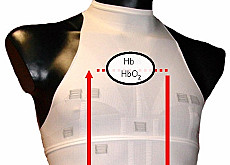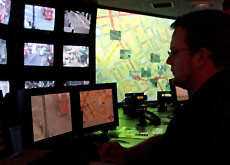Intelligent clothing tracks health

A Swiss-led consortium is busy designing "smart" clothing to monitor a person's vital functions, especially when recovering from a health scare or injury.
The Biotex programme, funded by the European Union, involves researchers from eight institutions as well as private companies interested in implementing the technology.
Self-monitoring of some vital functions, such as heart rate, has been common for some time. You might have come across joggers wearing a strap round their chest to measure their pulse, or even a fancy T-shirt that incorporates the same type of monitoring device.
But these monitors have little value beyond telling you how fast your heart is racing. What if you wanted to know how quickly you are losing body fluids such as sweat?
This is precisely the aim of the Biotex project: to develop sensors that can be incorporated into textiles to monitor a series of indicators – all with the advantage of not having to stick a needle into the wearer’s body.
So far the development of smart textiles has focused on measurements involving heart rate, breathing and body temperature, and applications have been reserved for athletes and people suffering from heart conditions.
“Our sensors will be concentrating on fluids, monitoring blood, sweat and urine of the wearer over an extended period,” project leader Jean Luprano from the Swiss Center for Electronics and Microtechnology in Neuchâtel told swissinfo.
Vital information
Luprano believes sweat analysis, for example, could provide plenty of health-related information. This could include measurements of ions such as potassium, a vital cog in the functioning of the body’s cells.
“The biggest problem is collecting a big enough sample to provide a relevant measurement,” he said.
Another issue is that measurements would normally involve chemical reactions that cannot be repeated indefinitely, which is why researchers have been looking at other techniques – optical and electrical means for example.
There are also more mundane concerns for the developers.
“The garments we are designing also have to be washable,” said Luprano. “The goal is to make it available for everyday use if you need it.”
One application the researchers also have in mind is monitoring large wounds that require a bandage to see if the injury is healing properly without disturbing the dressing. Another would be to monitor a skin graft, again without removing the bandage.
These possibilities would help save time and effort for medical staff at hospitals. Doctors could also monitor patients with heart problems without having to see them daily.
Unhealthy or superfit
According to Luprano, this smart clothing is generally not destined for healthy people, although athletes might find it interesting. “The advantages of wearing this type of clothing have to outweigh the disadvantages,” he said.
One profession that stands to benefit from the project is firefighters. There are already some in Paris who are testing prototype apparel.
“If I were in a risky environment, like a fireman might be, it could be useful to know that you should move because your temperature has risen too much for example,” Luprano said.
He also admits that a person could be tested for alcohol, or even drugs if necessary.
“Insurance companies would probably find this kind of application interesting, but it’s up to the population and the authorities to set limits on the use of this technology.”
swissinfo, Scott Capper in Neuchâtel
The Biotex project is a specific targeted research or innovation project, part of the sixth framework programme of the European Commission.
The consortium consists of eight partners from four countries.
It includes two research institutes in the field of micro- and nanotechnology, two firms active in clothing research, development and production, two universities involved in wearable bioengineering, and two companies expert in engineering and manufacturing textiles.
The project began in 2005 and will end early next year. Its budget is €3.1 million, including €1.9 million from the EU.
The Swiss Center for Electronics and Microtechnology is active in the fields of micro/nanotechnology, microelectronics, systems engineering as well as information and communication technologies.
It supplies customised microsystems, microelectronic designs and system solutions to industrial partners, as well as services for high-tech coatings and new materials.
The centre also develops its own commercial activities, either with existing companies or by creating spin-offs and start-up companies – 23 over the past ten years.
It has also signed a long-term contract with the Swiss authorities to finance its own applied research.
At the end of 2006 the company had 310 employees, over two-thirds of whom hold an academic degree. Its income reached €36 million (SFr60 million).

In compliance with the JTI standards
More: SWI swissinfo.ch certified by the Journalism Trust Initiative


You can find an overview of ongoing debates with our journalists here . Please join us!
If you want to start a conversation about a topic raised in this article or want to report factual errors, email us at english@swissinfo.ch.